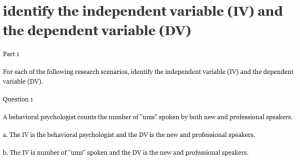Part 1
For each of the following research scenarios, identify the independent variable (IV) and the dependent variable (DV).
Question 1
A behavioral psychologist counts the number of “ums” spoken by both new and professional speakers.
a. The IV is the behavioral psychologist and the DV is the new and professional speakers.
b. The IV is number of “ums” spoken and the DV is the new and professional speakers.
c. The IV is new and professional speakers and the DV is number of “ums” spoken.
d. The IV is number of “ums”spoken and the DV is the behavioral psychologist.
Question 2
A clinical psychologist studies the depression scores of people in her therapy group and the scores of those on the waiting list for the therapy group.
a. The IV is depression scores and the DV is whether they are in therapy or on the waiting list.
b. The IV is whether they are in the therapy group or on the waiting list and the DV is the depression scores.
c. The IV is the people and the DV is the clinical psychologist.
d. The IV is the clinical psychologist and the DV is the depression scores.
Question 3
A cognitive psychologist measures the number of items remembered when presented in either a quiet or noisy condition.
a. The IV is the quiet or noisy condition and the DV is the number of items remembered.
b. The IV is the cognitive psychologist and the DV is the number of items remembered.
c. The IV is the number of items remembered and the DV is the quiet or noisy condition.
d. The IV is the quiet or noisy condition and the DV is the cognitive psychologist.
Question 4
A developmental pychologist counts the number of errors that children of different ages make during a conservation of mass tests.
a. The IV is developmental psychologist and the DV is the conservation of mass test.
b. The IV is number of errors and the DV is different ages.
c. The IV is different ages and the DV is number of errors.
d. The IV is conservation of mass test and the DV is children.
Question 5
A physiological psychologist gives a stimulant or a depressant to a rat and measures the number of open-field exploration boves entered.
a. The IV is the physiological psychologist and the DV is the rat.
b. The IV is the stimulant or depressant and the DV is the number of boxes entered.
c. The IV is the number of boxes entered and the DV is the stimulant or depressant.
d. The IV is the rat and the DV is the number of boxes entered.
Question 6
A school psychologist gives the Strong Campbell test to a group of students planning to go to college and those not planning to go to college.
a. The IV is the students going or not going to college and the DV is the Strong Campbell test scores.
b. The IV is the school psychologist and the DV is the Strong Campbell test scores.
c. The IV is the Strong Campbell test scores and the DV is the students going or not going to college.
d. The IV is the students going or not going to college and the DV is the school psychologist.
Question 7
A social psychologist measures the amount of time it takes someone to assist a stranded motorist in different parts of town.
a. The IV is the different parts of town and the DV is the stranded motorist.
b. The IV is the time and the DV is the different parts of town.
c. The IV is the different parts of town and the DV is the time.
d. The IV is the social psychologist and the DV is the stranded motorist.
Question 8 An educational psychologist works in three different classrooms to see if the number of windows affects student performance in the class.
a. The IV is student performance and the DV is the three different classrooms.
b. The IV is the number of windows and the DV is student performance.
c. The IV is the educational psychologist and the DV is student performance.
d. The IV is student performance and the DV is the educational psychologist.
Question 9
An environmental psychologist surveys young and old adults on their opinion about a new multi-story office building.
a. The IV is a new multi-story office building and the DV is the environmental psychologist.
b. The IV is the young and old adults and the DV is the survey.
c. The IV is young and old adults and the DV is their opinion.
d. The IV is the opinions and the DV is the survey.
Question 10
An industrial psychologist studies the number of cars produced on the assembly line during morning and evening shifts.
a. The IV is the assembly line and the DV is the number of cars produced.
b. The IV is the number of cars produced and the DV is the morning and evening shifts.
c. The IV is the industrial psychologist and the DV is the assembly line.
d. The IV is the morning and evening shifts and the DV is the number of cars produced.
